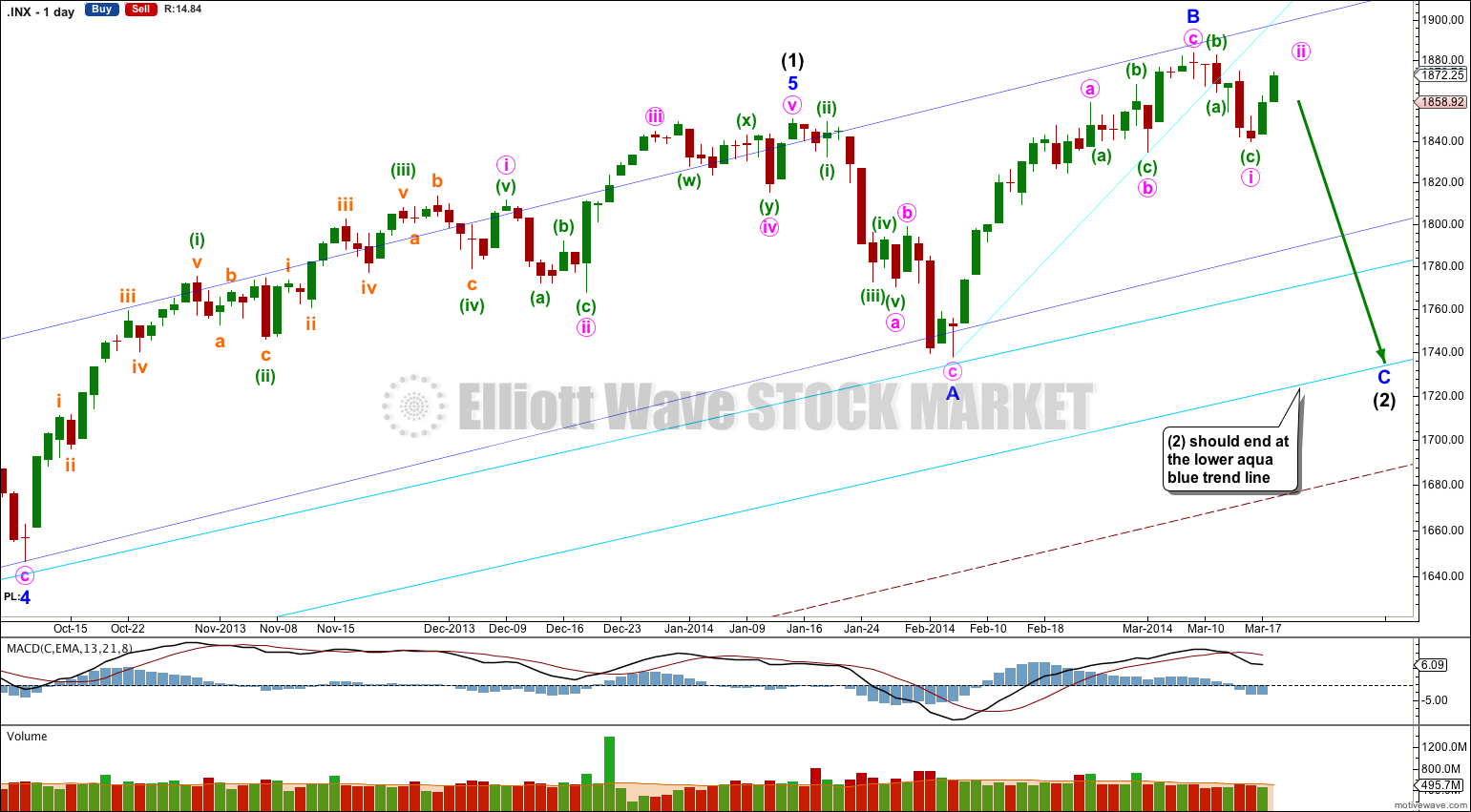Last analysis was invalidated by upwards movement. The wave count is changed.
Summary: Simple trend lines indicate the trend remains down. None of the major indexes have made new highs. The trend remains down at minor degree. I am expecting more downwards movement.
This analysis is published about 9:25 p.m. EST. Click on charts to enlarge.
Bullish Wave Count.
The aqua blue trend lines are critical for all wave counts. Draw the first trend line from the low of 1,158.66 on 25th November, 2011 to the next swing low at 1,266.74 on 4th June, 2012. Create a parallel copy and place it on the low at 1,560.33 on 24th June, 2013. While price remains above the lower of these two aqua blue trend lines we must assume the trend remains upwards. This is the main reason for the bullish wave count being my main wave count.
This bullish wave count expects a new bull market began at 666.79 for a cycle wave V. Within cycle wave V primary waves 1 and 2 are complete. Within primary wave 3 intermediate wave (1) is complete at 1,850.84. Intermediate wave (2) is continuing as an expanded flat correction.
Intermediate wave (2) should find strong support at the lower of the two aqua blue trend lines. Minor wave A lasted 14 days and minor wave B lasted a Fibonacci 21 days. I would expect minor wave C to be of a similar duration and to last about three to four weeks in total.
For this bullish wave count when intermediate wave (2) is complete then very strong sustained upwards movement would be expected as an intermediate degree third wave within a primary degree third wave upwards unfolds.
Upwards movement above 1,867.04 leaves the prior downwards wave as a three wave structure. If there has been a minor degree trend change at 1,883.57 then downwards movement can now only be a diagonal, and it is most likely an ending expanding diagonal.
Within an ending diagonal all subwaves must subdivide only as single zigzags, and the fourth wave should overlap first wave price territory. The second wave may not move beyond the start of the first wave above 1,883.57.
Within diagonals subwaves 2 and 4 normally retrace between 0.66 to 0.81 of waves 1 and 3. Here minute wave ii is a 0.78 retracement of minute wave i, nicely within the normal range.
Within minute wave i minuette wave (c) is just 0.50 short of 2.618 the length of minuette wave (a).
Within minute wave ii minuette wave (c) is 2.14 short of equality with minuette wave (a).
Minute wave iii must move beyond the end of minute wave i. This wave count requires a new low below 1,839.57.
If this wave count is invalidated with upwards movement then it may be that minor wave B is moving higher as a double zigzag.
Hourly Alternate.
By moving the degree of labeling down one degree the diagonal may be leading for minute wave i. If the next wave down for a third wave is shorter than 44 points then it would be shorter than the first wave and the diagonal must be contracting. A contracting ending diagonal would not be able to take price below the end of minor wave A at 1,737.92 and so it would more likely be a leading diagonal for a first wave.
I will keep this alternate in mind over the next few days, if the wave count remains valid with price below 1,883.57.
Bearish Alternate Wave Count.
This bearish wave count expects that the correction was not over at 666.79, and that may have been just cycle wave a of a huge expanded flat for a super cycle wave II. Cycle wave b upwards is a close to complete zigzag.
Within flat corrections the maximum common length of B waves in relation to A waves is 138%. So far cycle wave b is a 141% correction of cycle wave a. For this reason only this wave count is an alternate.
Within primary wave C of the zigzag intermediate wave (4) would be incomplete.
The subdivisions for intermediate wave (4) would be the same as the main wave count for intermediate wave (2). I would expect it to end at the lower aqua blue trend line.
At 2,190 primary wave C would reach 1.618 the length of primary wave A. When intermediate wave (4) is complete I would recalculate this target at intermediate degree. I have found Fibonacci ratios between actionary waves (1, 3 and 5) of impulses are more reliable than between A and C waves within zigzags for the S&P500.
If intermediate wave (5) lasts about five to six months it may end about October this year.






HI Lara,
There’s a high possibility of taking over 1900 due to today’s FOMC. If that’s the case , is this count still valid (or) do you suggest an alternative count?
Thx